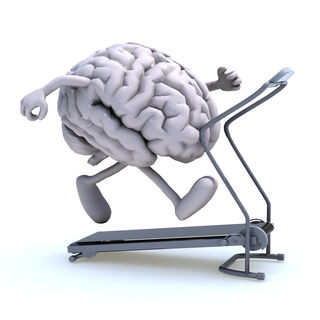Flow
Want to Improve Blood Flow to Your Brain? Start Exercising
Aerobic exercise improves cerebral blood flow and cerebrovascular regulation.
Posted May 15, 2020 Reviewed by Devon Frye

Most of us know that aerobic exercise is good for the human brain. Over the past decade, there's been a colossal amount of clinical research demonstrating the brain-boosting benefits of moderate-to-vigorous physical activity (MVPA) and high-intensity interval training (HIIT).
Since 2010, I've reported on gazillions of studies that identify specific brain benefits associated with doing cardio. In the past year alone, I've reported on this type of research here, here, here, here, here, here, here, here, here, here. To keep your eyes from glazing over, I stopped listing these hyperlinks after ten items; the list goes on and on and on.
After reading gobs of research on this topic, I believe the most noteworthy studies on exercise and cognition in recent months investigate the link between increased brain oxygenation and improved cerebrovascular regulation via aerobic exercise—which results in more robust cerebral blood flow (CBF) and better cognitive functions. (See "Bigger Brains and Higher Peak Oxygen Uptake Go hand in Hand" and "Want to Increase Brain Oxygenation? Locomotion May Be Key")
Another recent example: Researchers (Klein et al., 2019) from the University of Queensland in Australia found that HIIT workouts increase cerebral blood flow in young and old adults. Notably, the researchers conclude that interval workouts boost CBF velocity and that improved cerebrovascular health via cardio training may help to offset cognitive decline in older adults. (See "HIIT Can Increase Cerebral Blood Flow")

Aerobic Exercise Improves Cognition and Cerebrovascular Regulation
Based on the groundswell of evidence described above, it should come as no surprise that another recent study (Guadagni et al., 2020) found that inactive adults who started an exercise program increased cerebral blood flow to their brains and improved executive functions by sticking with an exercise program for six months. These findings were published on May 13 in the journal Neurology.
For this study on how "aerobic exercise improves cognition and cerebrovascular regulation in older adults," the researchers used a battery of neuropsychological tests to assess cognitive functions before and after a six-month aerobic exercise intervention in a cohort of 206 adults with an average age of 66. The researchers also used Transcranial Doppler ultrasound to measure changes in cerebral blood flow velocity before and after the study participants kickstarted their six-month exercise program.
"[Even] if you start an exercise program later in life, the benefit to your brain may be immense," senior author Marc Poulin, professor at the University of Calgary's Laboratory of Human Cerebrovascular Physiology in Canada, said in a news release. "Sure, aerobic exercise gets blood moving through your body. As our study found, it may also get blood moving to your brain, particularly in areas responsible for verbal fluency and executive functions. Our finding may be important, especially for older adults at risk for Alzheimer's and other dementias and brain disease."
One of the most interesting aspects of this study is that aerobic exercise seemed to have a significant impact on verbal fluency. "Our study showed that six months' worth of vigorous exercise may pump blood to regions of the brain that specifically improve your verbal skills as well as memory and mental sharpness," Poulin said. "This change in verbal fluency is what you'd expect to see in someone five years younger. At a time when these results would be expected to be decreasing due to normal aging, to have these types of increases is exciting."
Another important takeaway from the latest study (2020) by Marc Poulin and colleagues is that they've identified a dose-response of submaximal aerobic exercise that improves cerebrovascular regulation and cognition in older adults. The "tonic dose" (duration/intensity) of aerobic exercise needed to improve cerebrovascular regulation and cognition appears to be about forty minutes of cardio four times a week.
At the beginning of this study, each participant was enrolled in a supervised aerobic exercise program for twenty minutes, three times a week. As their fitness improved, study participants gradually increased the duration of their cardio sessions to an average of about 40 minutes per workout.
In addition to the three supervised sessions, participants were asked to work out once a week on their own after they'd established a healthy baseline of cardiorespiratory fitness (CRF). By the end of this six-month study, participants who improved their cerebral blood flow velocity and cerebrovascular regulation were doing at least 160 minutes of weekly aerobic exercise.
This study has some limitations: First, there wasn't a "non-exercise" control group. The researchers tried to compensate for this limitation by testing each of the 206 participants twice over an extended period before they started the supervised exercise program. Second, some of the weekly aerobic exercise was unsupervised; self-reported "doses" of unsupervised cardio workouts can be unreliable.
DISCLAIMER: Please use common sense and consult with your primary care physician before starting any new exercise program—especially if you are a middle-aged or older adult.
References
Veronica Guadagni, Lauren L. Drogos, Amanda V. Tyndall, Margie H. Davenport, Todd J. Anderson, Gail A. Eskes, R. Stewart Longman, Michael D. Hill, David B. Hogan, Marc J. Poulin. "Aerobic Exercise Improves Cognition and Cerebrovascular Regulation in Older Adults" Neurology (First published: May 13, 2020) DOI: 10.1212/WNL.0000000000009478




